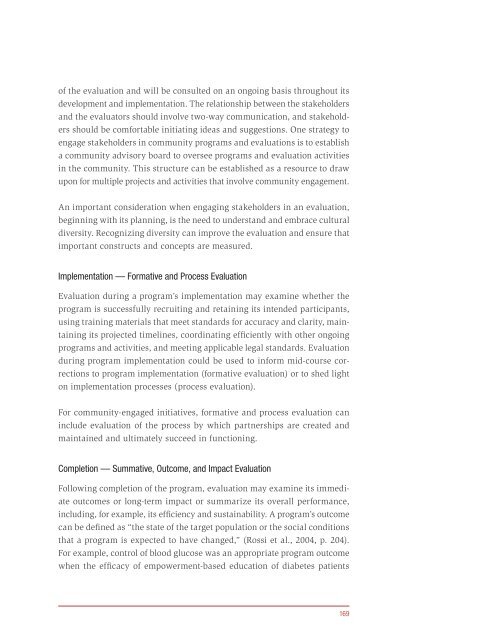Principles of Community Engagement (Second Edition)
Principles of Community Engagement (Second Edition)
Principles of Community Engagement (Second Edition)
Create successful ePaper yourself
Turn your PDF publications into a flip-book with our unique Google optimized e-Paper software.
<strong>of</strong> the evaluation and will be consulted on an ongoing basis throughout its<br />
development and implementation The relationship between the stakeholders<br />
and the evaluators should involve two-way communication, and stakehold-<br />
ers should be comfortable initiating ideas and suggestions One strategy to<br />
engage stakeholders in community programs and evaluations is to establish<br />
a community advisory board to oversee programs and evaluation activities<br />
in the community This structure can be established as a resource to draw<br />
upon for multiple projects and activities that involve community engagement<br />
An important consideration when engaging stakeholders in an evaluation,<br />
beginning with its planning, is the need to understand and embrace cultural<br />
diversity Recognizing diversity can improve the evaluation and ensure that<br />
important constructs and concepts are measured<br />
Implementation — Formative and Process Evaluation<br />
Evaluation during a program’s implementation may examine whether the<br />
program is successfully recruiting and retaining its intended participants,<br />
using training materials that meet standards for accuracy and clarity, maintaining<br />
its projected timelines, coordinating efficiently with other ongoing<br />
programs and activities, and meeting applicable legal standards Evaluation<br />
during program implementation could be used to inform mid-course corrections<br />
to program implementation (formative evaluation) or to shed light<br />
on implementation processes (process evaluation)<br />
For community-engaged initiatives, formative and process evaluation can<br />
include evaluation <strong>of</strong> the process by which partnerships are created and<br />
maintained and ultimately succeed in functioning<br />
Completion — Summative, Outcome, and Impact Evaluation<br />
Following completion <strong>of</strong> the program, evaluation may examine its immediate<br />
outcomes or long-term impact or summarize its overall performance,<br />
including, for example, its efficiency and sustainability A program’s outcome<br />
can be defined as “the state <strong>of</strong> the target population or the social conditions<br />
that a program is expected to have changed,” (Rossi et al , 2004, p 204)<br />
For example, control <strong>of</strong> blood glucose was an appropriate program outcome<br />
when the efficacy <strong>of</strong> empowerment-based education <strong>of</strong> diabetes patients<br />
169

















